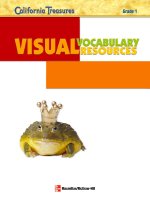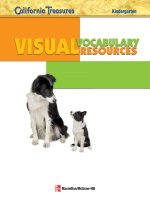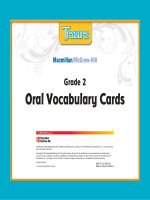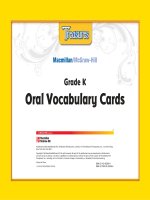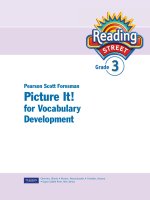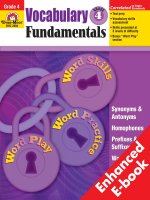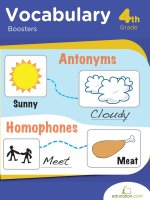treasures oral vocabulary cards grade k
Bạn đang xem bản rút gọn của tài liệu. Xem và tải ngay bản đầy đủ của tài liệu tại đây (17.12 MB, 246 trang )
Grade K
Oral Vocabulary Cards
Macmillan/McGraw-Hill
A
Published by Macmillan/McGraw-Hill, of McGraw-Hill Education, a division of The McGraw-Hill Companies, Inc., Two Penn Plaza,
New York, New York 10121.
Copyright © by Macmillan/McGraw-Hill. All rights reserved. No part of this publication may be reproduced or distributed in
any form or by any means, or stored in a database or retrieval system, without the prior written consent of The McGraw-Hill
Companies, Inc., including, but not limited to, network storage or transmission, or broadcast for distance learning.
Printed in China
1 2 3 4 5 6 7 8 9 10 DSS 12 11 10 9 8
ISBN 10: 0-02-202031-4
ISBN 13: 978-0-02-202031-6
The Lioness and the Ostrich Chicks
The Rabbit and the Coyote
Rooster Goes to Tío’s Wedding
Games Around the World
Brer Turtle Helps Out
The Turtle and the Sheep
How Partridge Built Canoes
The Two Frogs
Big, Big Trucks
Pizza, Please!
Little Juan and the Cooking Pot
The Three Wishes
Mama Mouse and El Gato
The Ugly Duckling
Hidden Homes
In Our Neighborhood
Acrefoot, the Barefoot Mailman
The Elves and the Shoemakers
How Thunder and Lightning Came to Be
Paul Bunyan and the Popcorn Blizzard
Animals in Winter
The Conceited Apple Branch
Let’s Go to a National Park!
Anansi and the Melon
Insect Hide and Seek
When Water Came to Visit
Powerful Plant-Eating Dinosaurs
The Blind Men and the Elephant
Fun Places
Mouse Deer Crosses the River
Table of Contents
D
o
y
o
u
t
h
in
k
a
lio
n
w
o
u
ld
b
e
a
g
o
o
d
m
o
t
h
e
r
f
o
r
a
b
a
b
y
o
s
tr
ic
h
t
o
h
a
v
e
?
W
h
y
o
r
w
h
y
n
o
t
?
L
o
n
g
, lo
n
g
a
g
o
, w
h
e
n
a
ll c
re
a
t
u
re
s
e
v
e
r
y
w
h
e
r
e
sp
o
k
e
t
h
e
sa
m
e
la
n
g
u
a
g
e
, a
m
o
t
h
e
r
o
s
t
r
ic
h
h
a
t
c
h
e
d
f
o
u
r
fi
n
e c
h
ic
k
s
. O
n
e
lo
v
e
ly
d
a
y
,
M
o
t
h
e
r
O
s
t
ric
h
t
o
o
k
h
e
r c
h
ic
k
s
f
o
r a
w
a
lk
. Y
e
s
, t
h
e
y
w
a
l
k
e
d
, f
o
r
e
v
e
n
t
h
o
u
g
h
o
s
t
ric
h
e
s h
a
v
e
fea
t
h
e
rs
, t
h
e
y
c
a
n
n
o
t
fl
y
.
“
K
lik
-k
lik
,
k
lik
-k
lik
, s
t
a
y c
lo
s
e
to
m
e
, m
y
c
h
ic
k
s
,”
s
a
id
M
o
t
h
e
r
O
s
t
rich
, “
s
o
t
h
a
t
I m
a
y
p
ro
t
e
c
t
y
o
u
fro
m
d
a
n
g
e
r
.”
“
K
lik
-
klik
,
k
lik
-k
lik
,”
sh
o
u
t
e
d
t
h
e
fo
u
r c
h
ic
k
s
a
s
t
h
e
y
ra
n
a
b
o
u
t
h
u
n
t
in
g
fo
r fo
o
d
in
th
e
t
a
ll
g
ra
ss
.
T
h
e
ir s
h
o
u
t
s
w
o
k
e
a
lo
n
e
ly lio
n
e
s
s
s
le
e
p
in
g
n
e
a
rb
y. “
W
h
a
t
a
lu
c
k
y
o
s
t
ric
h
t
o
h
a
v
e
fo
u
r
fi
n
e
c
h
ic
k
s
,”
s
ig
h
e
d
L
io
n
e
s
s.
“
I
w
is
h
t
h
e
y
w
e
re
m
in
e
.”
T
h
e
L
i
o
n
e
s
s
a
n
d
t
h
e
O
s
t
r
i
c
h
C
h
i
c
k
s
A
M
a
s
a
i
T
a
l
e
©
M
a
c
m
i
l
l
a
n
/
M
c
G
r
a
w
-
H
i
l
l
i
l
l
u
s
t
r
a
t
i
o
n
b
y
J
i
l
l
N
e
w
t
o
n
O
r
a
l
V
o
c
a
b
u
l
a
r
y
p
r
o
t
e
c
t
D
e
fi
n
e
:
P
r
o
t
e
c
t
m
e
a
n
s
t
o
k
e
e
p
s
a
f
e
.
E
x
a
m
p
l
e
:
A
s
e
a
t
b
e
l
t
w
i
l
l
p
r
o
t
e
c
t
y
o
u
w
h
e
n
r
i
d
i
n
g
i
n
a
c
a
r
.
A
s
k
:
W
h
a
t
r
u
l
e
s
d
o
y
o
u
h
a
v
e
i
n
s
c
h
o
o
l
t
o
p
r
o
t
e
c
t
y
o
u
f
r
o
m
g
e
t
t
i
n
g
h
u
r
t
?
E
L
L
C
o
m
p
a
r
e
a
n
d
C
o
n
t
r
a
s
t
P
o
i
n
t
t
o
a
n
d
n
a
m
e
t
h
e
l
i
o
n
e
s
s
.
P
o
i
n
t
t
o
a
n
d
i
d
e
n
t
i
f
y
t
h
e
o
s
t
r
i
c
h
m
o
t
h
e
r
a
n
d
c
h
i
c
k
s
.
A
s
k
:
W
h
i
c
h
a
r
e
b
i
r
d
s
:
o
s
t
r
i
c
h
e
s
o
r
l
i
o
n
s
?
A
r
e
t
h
e
c
h
i
c
k
s
b
a
b
y
l
i
o
n
s
o
r
b
a
b
y
o
s
t
r
i
c
h
e
s
?
G
u
i
d
e
c
h
i
l
d
r
e
n
t
o
d
e
s
c
r
i
b
e
t
h
e
t
w
o
a
n
i
m
a
l
s
.
A
d
d
i
t
i
o
n
a
l
V
o
c
a
b
u
l
a
r
y
R
e
r
e
a
d
t
h
e
s
e
l
e
c
t
i
o
n
.
I
n
t
r
o
d
u
c
e
t
h
e
u
n
d
e
r
l
i
n
e
d
w
o
r
d
s
u
s
i
n
g
t
h
e
v
o
c
a
b
u
l
a
r
y
r
o
u
t
i
n
e
o
n
H
o
w
t
o
U
s
e
t
h
e
O
r
a
l
V
o
c
a
b
u
l
a
r
y
C
a
r
d
s
.
1
N
KC
R
D
OV_F
L
_U
1
W
1_R
D
0
9
.i
ndd
1
NKCRDOV_F
L_U1W1_RD0
9.indd
1
1/1
2
/
0
7
3
:
4
3
:54
PM
O
r
a
l
V
o
c
a
b
u
l
a
r
y
E
L
L
C
o
m
p
o
s
e
S
e
n
t
e
n
c
e
s
H
e
l
p
c
h
i
l
d
r
e
n
n
a
m
e
i
n
s
e
c
t
s
t
h
e
y
h
a
v
e
s
e
e
n
a
n
d
t
e
l
l
w
h
e
r
e
t
h
e
y
h
a
v
e
s
e
e
n
t
h
e
m
.
P
r
o
v
i
d
e
s
e
n
t
e
n
c
e
f
r
a
m
e
s
,
s
u
c
h
a
s
:
I
s
a
w
a
(
n
)
_
_
_
_
_
_
.
(
g
r
a
s
s
h
o
p
p
e
r
,
b
u
t
t
e
r
fl
y
,
l
a
d
y
b
u
g
,
fl
y
)
I
t
w
a
s
_
_
_
_
_
_
.
(
o
n
a
s
t
i
c
k
,
o
n
a
l
e
a
f
,
i
n
t
h
e
g
r
a
s
s
,
i
n
a
p
u
d
d
l
e
,
i
n
t
h
e
s
a
n
d
)
In
se
c
t H
id
e
an
d
S
e
e
k
W
h
a
t
i
n
s
e
c
t
s
h
a
v
e
y
o
u
s
e
e
n
o
u
t
d
o
o
r
s
?
H
a
v
e
y
o
u
e
v
e
r
l
o
o
k
e
d
a
t
t
h
e
m
v
e
r
y
c
l
o
s
e
l
y
?
W
h
a
t
d
i
d
y
o
u
s
e
e
?
I
n
s
e
c
t
s
a
r
e
a
l
l
a
r
o
u
n
d
u
s
.
B
u
t
t
h
o
u
g
h
i
n
s
e
c
t
s
a
r
e
e
v
e
r
y
w
h
e
r
e
,
t
h
e
y
c
a
n
b
e
h
a
r
d
t
o
fi
n
d
.
W
h
y
?
B
e
c
a
u
s
e
s
o
m
e
i
n
s
e
c
t
s
a
r
e
g
o
o
d
a
t
h
i
d
i
n
g
.
T
h
e
s
h
a
p
e
s
o
f
t
h
e
i
r
b
o
d
i
e
s
a
n
d
t
h
e
i
r
c
o
l
o
r
s
c
a
n
h
e
l
p
t
h
e
m
b
l
e
n
d
i
n
w
i
t
h
t
h
e
i
r
s
u
r
r
o
u
n
d
i
n
g
s
.
Y
o
u
h
a
v
e
t
o
l
o
o
k
v
e
r
y
,
v
e
r
y
c
l
o
s
e
l
y
t
o
s
e
e
t
h
e
m
.
H
a
v
e
y
o
u
e
v
e
r
p
r
i
c
k
e
d
y
o
u
r
fi
n
g
e
r
o
n
a
r
o
s
e
t
h
o
r
n
?
O
u
c
h
!
I
t
m
i
g
h
t
n
o
t
h
a
v
e
b
e
e
n
a
t
h
o
r
n
a
t
a
l
l
.
I
t
m
i
g
h
t
h
a
v
e
b
e
e
n
a
n
i
n
s
e
c
t
!
A
t
h
o
r
n
b
u
g
h
a
s
a
s
h
a
p
e
t
h
a
t
m
a
k
e
s
i
t
l
o
o
k
j
u
s
t
l
i
k
e
a
t
h
o
r
n
.
T
h
o
r
n
s
a
r
e
n
’
t
t
a
s
t
y
,
s
o
m
o
s
t
h
u
n
g
r
y
c
r
e
a
t
u
r
e
s
w
i
l
l
g
o
r
i
g
h
t
p
a
s
t
t
h
o
r
n
b
u
g
s
.
L
o
o
k
a
t
t
h
e
s
t
e
m
i
n
t
h
e
p
h
o
t
o
.
C
a
n
y
o
u
s
e
e
t
h
e
t
h
o
r
n
b
u
g
?
H
o
w
d
o
e
s
i
t
l
o
o
k
l
i
k
e
t
h
e
r
e
a
l
t
h
o
r
n
s
?
H
e
r
e
’
s
a
n
i
n
t
e
r
e
s
t
i
n
g
f
a
c
t
a
b
o
u
t
t
h
o
r
n
b
u
g
s
.
W
h
e
n
y
o
u
n
g
t
h
o
r
n
b
u
g
s
o
n
a
s
t
e
m
s
e
n
s
e
d
a
n
g
e
r
,
t
h
e
y
s
h
a
k
e
t
o
g
e
t
h
e
r
.
T
h
e
i
r
m
o
t
h
e
r
f
e
e
l
s
t
h
e
s
t
e
m
m
o
v
e
a
n
d
c
o
m
e
s
t
o
h
e
l
p
.
i
n
s
e
c
t
s
D
e
fi
n
e
:
I
n
s
e
c
t
s
a
r
e
s
m
a
l
l
a
n
i
m
a
l
s
w
i
t
h
s
i
x
l
e
g
s
a
n
d
b
o
d
i
e
s
t
h
a
t
h
a
v
e
t
h
r
e
e
p
a
r
t
s
.
E
x
a
m
p
l
e
:
B
e
e
t
l
e
s
,
fi
r
e
fl
i
e
s
,
a
n
d
a
n
t
s
a
r
e
i
n
s
e
c
t
s
.
A
s
k
:
W
h
a
t
f
a
c
t
s
d
o
y
o
u
k
n
o
w
a
b
o
u
t
i
n
s
e
c
t
s
?
©
M
a
c
m
i
l
l
a
n
/
M
c
G
r
a
w
-
H
i
l
l
p
h
o
t
o
©
K
O
N
R
A
D
W
O
T
H
E
/
M
i
n
d
e
n
P
i
c
t
u
r
e
s
i
n
t
e
r
e
s
t
i
n
g
D
e
fi
n
e
:
W
h
e
n
s
o
m
e
t
h
i
n
g
i
s
i
n
t
e
r
e
s
t
i
n
g
,
y
o
u
w
a
n
t
t
o
p
a
y
a
t
t
e
n
t
i
o
n
t
o
i
t
.
E
x
a
m
p
l
e
:
T
h
e
b
o
o
k
w
a
s
s
o
i
n
t
e
r
e
s
t
i
n
g
t
h
a
t
I
r
e
a
d
i
t
t
w
i
c
e
.
A
s
k
:
W
h
a
t
i
s
s
o
m
e
t
h
i
n
g
i
n
t
e
r
e
s
t
i
n
g
y
o
u
l
e
a
r
n
e
d
t
o
d
a
y
?
A
d
d
i
t
i
o
n
a
l
V
o
c
a
b
u
l
a
r
y
R
e
r
e
a
d
t
h
e
s
e
l
e
c
t
i
o
n
.
I
n
t
r
o
d
u
c
e
t
h
e
u
n
d
e
r
l
i
n
e
d
w
o
r
d
s
u
s
i
n
g
t
h
e
v
o
c
a
b
u
l
a
r
y
r
o
u
t
i
n
e
o
n
H
o
w
t
o
U
s
e
t
h
e
O
r
a
l
V
o
c
a
b
u
l
a
r
y
C
a
r
d
s
.
1
N
K
C
R
D
O
V
_
FL
_
U
9
W
1
_
R
D
0
9
.
i
n
d
d
1
2
/
1
2
/
0
7
1
0
:
0
9
:3
8
A
M
2/12
/07
10:09:
38 AM
How to Use the Oral Vocabulary Cards
Key Features of the
Oral Vocabulary Cards
• The Oral Vocabulary Cards feature folk tales from
around the world and high-interest nonfiction. There
is one set of four cards for each selection/per week.
• Every card has a full-color illustration or photo on
the front. The images can be shown while reading
the text aloud. They can be used to reinforce the
Wonderful Words and additional words. These words
build children’s oral vocabularies beyond their reading
vocabularies. A minimum of eight words are included
in each selection.
• A Wonderful Words section provides a routine for
introducing new vocabulary. Introduce highlighted
words using the following routine:
Define: offers a student-friendly definition
Example: uses the word in a context children will
relate to
Ask: offers a question that requires children to apply
the word in their own sentences as they reply
• Additional Vocabulary Words are provided for more
vocabulary opportunities. Introduce the underlined
vocabulary using the Define/Example/Ask routine.
• English Learner (EL) strategies help unlock the
meanings of words through engaging activities for all
children.
• A Retelling feature helps children use the illustrations
and photographs to retell the events and facts.
Using the Oral Vocabulary Cards
While You Read
• Use the focus questions before the selection to start
a discussion with children before reading. Evaluate
children’s prior knowledge of the concepts introduced
in the story and use the discussion to build children’s
background.
• Read the selection aloud, engaging children by
pointing out key elements of the illustrations or
photos that help make the text comprehensible. As
you encounter a highlighted word, stop and use the
Define/Example/Ask routine to teach the word and
provide time for discussion.
• As an alternative, first read the selection straight
through and then go back to use the Define/Example/
Ask routine to teach the Wonderful Words.
Using the Oral Vocabulary Cards
Guided Rereading
On a subsequent reading, use the same Define/Example/
Ask routine to teach the underlined additional vocabulary
words. Use the EL strategies if you have not already done
so. Use language frames and sentence starters so children
have a context in which to supply vocabulary words.
Encourage them to echo the sentences when the frames
are complete.
Retelling
Do a Modeled Retelling of the selection by holding up
each card and talking about what you see as you ask
children questions found in the Retell box.
For example, for “The Turtle and the Sheep,” a Haitian
tale, retell the story as follows:
Card 1: One day Tortu, the turtle, gave Marcel, the sheep,
money for food. Marcel told Tortu that he would help
him some day. He told Tortu to sing a special song and he
would come.
Card 2: Later Yvette, Tortu’s friend, came to dinner and
brought some friends. She brought so many friends that
Tortu wondered if there would be enough food for all the
guests.
Card 3: Tortu added so many vegetables that the pot
became too heavy. It tipped over and fell on Tortu. He
was trapped! Fortunately, he remembered the song
Marcel had taught him and sang it. Suddenly, Marcel
arrived with his sheep friends.
Card 4: Marcel lifted up the pot and freed Tortu. He saved
Tortu’s life! Marcel and his friends stayed to eat dinner
with Tortu! Now they were all friends.
Developing Conversations
The Oral Vocabulary Cards are linked to the weekly and
unit themes. They are designed to develop children’s
listening and speaking skills. As you share the stories with
children, use the following strategies to engage children
in independent and group responses.
• Motivate discussion by asking children about their
experiences. Use the focus questions at the beginning
of each selection. Discuss unfamiliar concepts by
relating to children’s personal experiences. Use
examples from your own life to make concepts clear.
• Pause long enough to allow children to think and
respond.
• Ask children, one by one, to retell the events of the
story in a group situation. Encourage each child to tell
one event or fact in chronological order.
• Practice fluency with the patterned parts and repetitive
stanzas.
• Have children role-play parts of the story by becoming
characters. Have a narrator tell the story while children
use the characters’ words at the appropriate time.
Allow groups of children to become one character
so that children at a beginning language level can
participate.
• Provide a simple synopsis of the story and invite
children to add the details they remember.
Intensive Vocabulary Instruction
For children needing additional vocabulary
development, follow the Intensive Vocabulary
5-Day Plan below. Spend 15-20 minutes a day providing
targeted vocabulary instruction and practice using
the Oral Vocabulary Cards.
Intensive Vocabulary 5-Day Plan
Day 1: Review the previous week’s words. Then
administer the Oral Vocabulary Pretest in the
Teacher’s Resource Book. If time allows, read the
selection aloud for enjoyment and prompt children to
offer personal responses.
Day 2: Read the selection and teach the highlighted
words using the Define/Example/Ask routines
provided.
Day 3: Reread the selection and teach the underlined
words using the Define/Example/Ask routine.
Day 4: Revisit the selection, review the vocabulary
words, and guide children in a retelling.
Day 5: Administer the Oral Vocabulary Posttest in the
Teacher’s Resource Book. Allow time for children to
independently retell the selection. Prompt them to
use the new vocabulary taught by providing sentence
frames or sentence starters.
Periodic Review
Once a set of words has been taught, continue to
review the words throughout the upcoming weeks.
Children will need several weeks of continuous review
to master many of these words. To provide ample
review:
• Review the previous week’s words at the beginning of
each new week.
• Incorporate the new words into classroom
discussions. Rephrase children’s responses, when
appropriate, to use new words. Ask children to repeat.
• Use the new words in transition activities. For
example, ask children to name a time they were
exhausted as they line up for recess, one by one.
• At the end of the each unit, revisit all the Oral
Vocabulary Card stories for that unit. State a targeted
vocabulary word, and ask children to use it in a
sentence that tells about a story or something they
learned in that unit.
• Send home the list of vocabulary words taught and
sentence starters for families to engage their children
in discussions using the words.
Academic Language
Many children struggle in school due to their limited
knowledge and use of academic language. Academic
words include those harder Tier 2 words that appear
in much of children’s reading materials as well as the
language of instruction.
Tier 1 Words: Everyday words (cat, apple, table)
Tier 2 Words: Academic words (exhausted, analyze,
majority)
Tier 3 Words: Content specific words (lava,
Louisiana Purchase, viceroy)
The words chosen for instruction on the Oral
Vocabulary Cards were carefully sequenced and
selected by consulting three sources: (1) the Living Word
Vocabulary list, (2) Avril Coxhead’s list of High-Incidence
Academic Words, and (3) Andrew Biemiller’s Words
Worth Teaching list.
have? Why or why not?
Long, long ago, when all creatures everywhere spoke the same
language, a mother ostrich hatched four fi ne chicks. One lovely day,
Mother Ostrich took her chicks for a walk. Yes, they walked, for even
though ostriches have feathers, they cannot fl y.
“Klik-klik, klik-klik, stay close to me, my chicks,” said Mother
Ostrich, “so that I may protect you from danger.”
“Klik-klik, klik-klik,” shouted the four chicks as they ran about
hunting for food in the tall grass.
Their shouts woke a lonely lioness sleeping nearby. “What a lucky
ostrich to have four fi ne chicks,” sighed Lioness. “I wish they were
mine.”
The Lioness and the Ostrich Chicks
A Masai Tale
©Macmillan/McGraw-Hill
illustration by Jill Newton
Oral
Vocabulary
protect
Defi ne: Protect means to keep
safe.
Example: A seat belt will
protect you when riding in a
car.
Ask: What rules do you have
in school to protect you from
getting hurt?
Intensive Vocabulary Support Reread the selection. Introduce the underlined words
using the vocabulary routine on How to Use the Oral Vocabulary Cards.
UNIVERSAL ACCESS
English Learners
Compare and Contrast
Point to and name the lioness.
Point to and identify the
ostrich mother and chicks.
Have children repeat. Then
ask: Which are birds: ostriches
or lions? Are the chicks baby
lions or baby ostriches? Guide
children to describe the two
animals.
1
Vocabulary
UNIVERSAL ACCESS
English Learners
Lioness was as clever as she was lonely. “I will imitate Mother
Ostrich’s voice so the chicks will follow me,” she decided.
Lioness waited patiently. Soon a grasshopper leapt out of the tall
grass. Mother Ostrich could not resist such a juicy morsel and chased
after the insect.
Lioness saw her chance. She imitated Mother Ostrich and called to
the chicks, “Klik-klik, klik-klik, stay close to me, my chicks.”
Hearing the familiar call, the chicks went to Lioness. She quickly
gathered the chicks together to take them to her den.
When Mother Ostrich saw Lioness taking her chicks away, she ran
after them shouting, “Klik-klik, klik-klik, don’t eat my chicks! Give me
back my chicks!”
“Tuk-ten, tuk-ten, these are my children,” said Lioness. “Tuk-ten,
tuk-ten, a mother does not eat her children!”
Mother Ostrich ran after Lioness, calling, “Klik-klik, klik-klik, give me
back my chicks!”
imitate
Defi ne: When you imitate
someone, you copy the way he
or she behaves.
Example: I can imitate the
purring sound my cat makes.
Ask: What animal sounds can
you imitate?
The Lioness and the Ostrich Chicks
©Macmillan/McGraw-Hill
illustration by Jill Newton
together
Defi ne: Together means to be
with others in a group.
Example: The children played
ball together in the park.
Ask: What do you and your
friends like to do together?
Summarize Ask a child to do
an action, such as waving.
Say that you will imitate him
or her as you perform the
same action. Help children
understand how Lioness got
the chicks away from Mother
Ostrich. Ask: What does
Mother Ostrich say to her
chicks? What does Lioness say
to the chicks?
2
took my chicks for her own! Please help me get them back.”
Gazelle replied, “Lions roar. Ostriches do not. The chicks are yours. I
will talk to Lioness.”
Next Mother Ostrich went to Giraffe and said, “Oh gentle Giraffe,
please help me. Lioness took my chicks for her own!”
Giraffe replied, “Lions have four legs. Ostriches only have two.
The chicks are yours. I will talk to Lioness.”
Then Mother Ostrich went to Mongoose and said, “Oh fearless
Mongoose, please help me. Lioness took my chicks for her own!”
Mongoose said, “Lions have tails. Ostriches do not. The chicks
resemble you in every way. I will help you. Let’s call a meeting at the
giant anthill. But fi rst we must dig a tunnel.”
Together, Mongoose and Mother Ostrich dug a tunnel under the
giant anthill and out the other side. The tunnel was just large enough
for Mongoose but much too small for Lioness.
©Macmillan/McGraw-Hill
illustration by Jill Newton
The Lioness and the Ostrich Chicks
Oral
Vocabulary
resemble
Defi ne: If you resemble
someone, you look or act like
him or her.
Example: The two sisters
resemble each other because
they both have red hair.
Ask: How do you resemble
people in your family?
UNIVERSAL ACCESS
English Learners
Compose Sentences Point to
and identify Gazelle, Giraffe,
and Mongoose. Have children
repeat three times. Then ask
children what Mother Ostrich
says to each animal. Reinforce
what each animal says to
Ostrich. Help children to
complete the sentences:
Lions have _________. Ostriches
have ______.
33
Vocabulary
The next day, all the animals met Lioness at the anthill. Mother
Ostrich begged Lioness, “Please return my chicks to me.”
Lioness roared, “Tuk-ten, tuk-ten, these are my children!” She then
faced each animal in turn and demanded, “Whose children are they?”
The animals shook in fear of Lioness. They were too scared to
tell her what they thought. Each animal pointed to Lioness and said,
“These chicks are yours.”
But in front of the anthill, Mongoose said, “No one could
mistake these chicks for baby lions! They belong to Mother Ostrich!”
Then Mongoose dove into the tunnel. Lioness roared and leapt after
Mongoose. But the hole was too small for her. She pawed and clawed
at the tunnel entrance.
“I know you are in there, Mongoose! I will wait here till you come
out!” shouted Lioness.
But Mongoose had already slipped out the other end of the tunnel.
Lioness waited and waited at the entrance for Mongoose to
come out. And while she waited, Mother Ostrich took her chicks
home at last!
animal
Defi ne: An animal is a living
creature. Dogs, cats, birds,
lions, insects, and fi sh are all
animals.
Example: Sharks can be
dangerous animals.
Ask: If you could be an animal,
what animal would you be?
Tell why you picked that
animal.
Help children use the
pictures to retell the story.
Card 1: What does Lioness
want? Why?
Card 2: How does Lioness
get the chicks? How does
Mother Ostrich feel?
Card 3: Who does Ostrich
ask for help? What does
each animal say to her?
Card 4: How does
Mongoose help Ostrich?
How does the story end?
Retell
The Lioness and the Ostrich Chicks
©Macmillan/McGraw-Hill
illustration by Jill Newton
4
that is easier to get done when you work together?
One day in the hot desert, a cottontail rabbit was sitting under a
large cactus plant. All at once, a coyote came running by.
When the coyote spotted the rabbit, he stopped. “Hello, little
friend,” he said. “What are you doing?”
“I’m just thinking about why coyotes have long tails,” said the
rabbit. “Doesn’t your long tail slow you down when you run?”
“Not at all,” replied the coyote. “I can run faster than any animal in
the desert.”
“Well then, we should have a race next week,” said the rabbit.
“Let’s race through our whole land.”
“Good idea!” agreed the coyote. “And to make the race
more exciting , the winner gets to eat the loser!”
The Rabbit and the Coyote
A Pueblo Tale
©Macmillan/McGraw-Hill
illustration by Mary Newell DePalma
Oral
Vocabulary
exciting
Defi ne: Something that is
exciting is a lot of fun and not
boring.
Example: A roller coaster ride
is exciting.
Ask: What is the most exciting
thing you have done? Would
you like to do it again? Why or
why not?
Intensive Vocabulary Support Reread the selection. Introduce the underlined words
using the vocabulary routine on How to Use the Oral Vocabulary Cards.
UNIVERSAL ACCESS
English Learners
Activate Background
Knowledge Point to and
identify the rabbit and the
coyote. Ask: How do coyotes
move? How do rabbits move?
Which animals are bigger:
rabbits or coyotes? Which do
you think are faster?
1
Vocabulary
The rabbit agreed. He had a plan. That night, he sent for his sisters
and brothers, aunts, uncles, and cousins. All the rabbits stopped their
playing, eating, and other activities to come. They traveled from the
four corners of the land.
“If we want to beat the coyote in the race, we all have to
cooperate ,” explained the rabbit.
“Together, we can do it!” shouted the rabbit family.
On the day of the race, the coyote met the rabbit by the cactus
plant again. “Are you ready, little friend?” asked the coyote. “Or
should I just eat you now and save time?”
“Let’s race,” said the rabbit. “You can run across the land as you
always do. I will run under the ground. We’ll see who is faster.” With
that, the rabbit hopped into a hole in the ground.
The coyote ran east for many days. He did not see the rabbit again
until he arrived in the eastern corner of the land. Then up jumped a
rabbit from a hole in the ground.
“Looks like I got here fi rst!” said the rabbit. What the coyote didn’t
know was that this was the fi rst rabbit’s sister!
activity
Defi ne: An activity is something
you do.
Example: My favorite activity is
swimming.
Ask: What is your favorite
activity? Why do you like to
do it?
The Rabbit and the Coyote
©Macmillan/McGraw-Hill
illustration by Mary Newell DePalma
cooperate
Defi ne: When you cooperate,
you work together with others
to do something.
Example: Everyone must
cooperate to keep our
classroom neat.
Ask: How do you cooperate
with your classmates to get a
job done?
UNIVERSAL ACCESS
English Learners
Compose Sentences Help
children brainstorm ways that
they cooperate at home and
at school, for example helping
to clean up, helping to get
ready for dinner, or helping
to get ready to go on a trip.
Provide the following sentence
frame: I cooperate when I
_______.
2
English Learners
The coyote turned and started to run north. He ran north for many
days. When he arrived at the northern corner of the land, a rabbit
poked his head out of the ground.
“I beat you again!” said the rabbit. What the coyote didn’t know
was that this was the fi rst rabbit’s brother!
Now the coyote tried harder than ever. He really wanted to win! He
ran west as fast as he could. He ran for many days. But when he arrived
at the western corner of the land, a rabbit jumped out of the ground
again.
“Slowpoke!” teased the rabbit. What the coyote didn’t know was
that this was the fi rst rabbit’s uncle!
Turning south, the coyote tried to run faster. By now, he was
exhausted . When he fi nally reached the southern corner of the land,
a rabbit popped up in front of him. What the coyote didn’t know was
that this was the fi rst rabbit’s cousin!
©Macmillan/McGraw-Hill
illustration by Mary Newell DePalma
©Macmillan/McGraw-Hill
illustration by Mary Newell DePalma
The Rabbit and the Coyote
Oral
Vocabulary
exhausted
Defi ne: When you are
exhausted, you are very tired.
Example: The campers were
exhausted after the long hike.
Ask: If you were exhausted,
would you want to take a nap
or fi nish a project?
Discuss Say: The coyote runs
really fast, but still the rabbit
seems to always beat him.
What trick is the rabbit family
playing? Do you think what
they are doing is fair? Why or
why not?
33
Vocabulary
It took the coyote days to limp back to the starting point of the
race. When he fi nally arrived, the fi rst rabbit was there to greet him.
“I see that the race was hard on you!” said the rabbit, looking
relaxed and well-rested. “I guess a long tail really does slow an animal
down! Now come over here, so I can eat you.”
The coyote was embarrassed. He knew the rabbit would not really
eat him, but he ran away as fast as he could. As he ran, he tucked his
long tail between his legs.
That night, the rabbit’s whole family gathered together. They
laughed and laughed as they talked about the trick they had played
on the long-tailed coyote. And they were all very proud of their own
short tails!
gather
Defi ne: Gather means to come
together in one place.
Example: On Saturday, Lily’s
family will gather in the park
for a picnic.
Ask: When do your family
members gather? What do they
do when they gather?
Help children use the
pictures to retell the story.
Card 1: Where are the
rabbit and the coyote now?
What two desert animals is
the story about?
Card 2: Do the rabbits run
above the ground or under
the ground during the race?
How is this different from
the way the coyote runs?
Card 3: What happens each
time the coyote reaches a
corner of the land? Who are
the rabbits the coyote sees?
Card 4: Who wins the race?
How? What do the animals
do after the race?
Retell
The Rabbit and the Coyote
©Macmillan/McGraw-Hill
illustration by Mary Newell DePalma
4
English Learners
What special occasions do you and your family celebrate? Do you like
dressing up for these occasions? Why or why not?
Once upon a time, Rooster’s uncle, or tío, was getting married.
Rooster put on his very best suit for this important family occasion .
Then off he went, walking down the road, feeling very proud and fi ne.
On the way, Rooster noticed two plump kernels of corn lying in the
mud. Rooster knew that if he ate the corn, his beak would get muddy,
and then he would not look his best. But the corn kernels looked so
tasty, he gobbled them anyway.
“Now my beak is all muddy! What shall I do?” crowed Rooster.
Rooster asked Grass for help. “Sweet Grass, won’t you wipe the mud
from my beak so that I may go to Tío’s wedding?”
Grass replied, “No, I won’t.”
Rooster Goes to Tío’s Wedding
A Tale from Cuba
©Macmillan/McGraw-Hill
illustration by Roge Girard
Oral
Vocabulary
occasion
Defi ne: An occasion is an
important and special event.
Example: A wedding is a very
happy occasion.
Ask: What do you like to wear
on special occasions?
Intensive Vocabulary Support Reread the selection. Introduce the underlined words
using the vocabulary routine on How to Use the Oral Vocabulary Cards.
Identify Story Elements Point
to and identify Rooster.
Explain that roosters are male
chickens. Have children point
to the rooster and say: cock-
a-doodle-doo! Point to and
identify the kernels of corn
and have children repeat after
you. Guide children to act out
gobbling the kernels of corn
with you.
1
